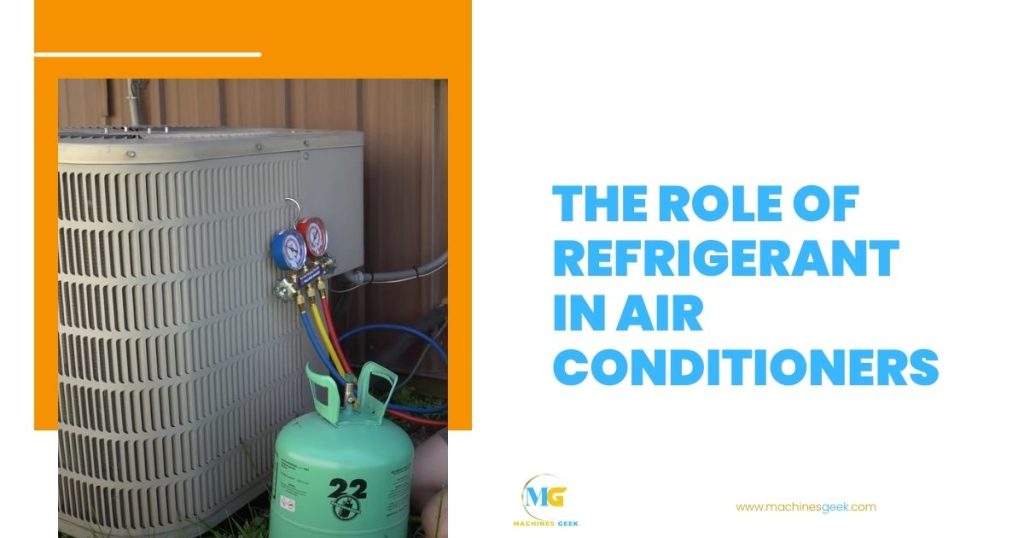Where Do You Put Freon in an Air Conditioner? Freon is typically added to an air conditioner through the service valve located on the low-pressure side of the system. Air conditioners require Freon to cool and regulate the temperature of indoor spaces.
To ensure proper functioning, Freon levels must be maintained. The process involves adding Freon at the service valve, which is usually found on the low-pressure side of the air conditioner. It’s important to note that only certified HVAC professionals should handle this task, as improper handling or overcharging can lead to serious issues.
We will discuss where exactly you should put Freon in an air conditioner and the importance of professional assistance to ensure a safe and efficient cooling system.
The Role Of Refrigerant In Air Conditioners
The role of refrigerant in an air conditioner is crucial for its cooling process. Refrigerant, also known as freon, plays a key function in the overall functioning of an air conditioning system.
Refrigerant is responsible for absorbing heat from the indoor air and then releasing it outside, resulting in a cooling effect. It undergoes a cycle of evaporation and condensation, which allows it to efficiently transfer heat from one area to another.
The importance of refrigerant in an air conditioning system lies in its ability to facilitate the cooling process by effectively absorbing and removing heat. Through the evaporation and condensation process, the refrigerant cools the air within the system, ensuring a comfortable indoor environment.
Properly maintaining the refrigerant levels and monitoring its condition is essential for the optimal performance of an air conditioning unit. Periodic inspections and refilling of refrigerant, if necessary, can ensure that the system operates efficiently and effectively.

Freon In Air Conditioners
Freon, also known as a refrigerant, is an integral component of air conditioners. It plays a crucial role in cooling the air that is circulated throughout your space. Without Freon, air conditioners would not be able to effectively regulate temperature and create a comfortable environment.
Freon is a type of chemical compound that undergoes a phase change from a gas to a liquid and back again, absorbing heat from the surrounding air in the process. This allows it to remove warm air from the designated area, leaving behind cool and refreshing air.
There are different types of refrigerants used in air conditioners, including R-22 and R-410A. R-22, also known as HCFC-22, has been the most commonly used refrigerant for many years. However, due to its harmful impact on the environment, its production has been phased out. R-410A, on the other hand, is a more environmentally friendly alternative and has become the standard refrigerant used in modern air conditioning systems.
Locating The Refrigerant Lines
Understanding the components of an air conditioning system is important in order to locate the refrigerant lines. The refrigerant lines are an integral part of the system and play a crucial role in the cooling process. They are responsible for circulating the refrigerant, which absorbs heat from the indoor air and releases it outside. It is essential to know where the lines are located to properly maintain and service the air conditioner.
Typically, the refrigerant lines are made of copper tubing and are insulated to prevent any heat loss. They can be found connecting the outdoor condensing unit to the indoor evaporator coil. The larger line, known as the suction line or the low-pressure line, carries the cooled refrigerant back to the condensing unit. On the other hand, the smaller line, known as the liquid line or the high-pressure line, carries the compressed and heated refrigerant to the evaporator coil.
Identifying the refrigerant lines is crucial for various reasons such as adding Freon to an air conditioner. Freon, or refrigerant, may need to be added if the system is low on refrigerant, which can lead to reduced cooling efficiency. By locating the refrigerant lines, homeowners can properly add Freon to their air conditioner and ensure optimal performance.
Equipment Needed For Adding Freon
- Refrigerant gauge set
- Refrigerant canister with the correct type and amount of Freon
- Ensure the air conditioner is turned off and unplugged
- Wear safety goggles and gloves to protect your eyes and skin from contact with the refrigerant
- Work in a well-ventilated area to avoid inhaling the fumes
- Keep open flames, cigarettes, and other sources of ignition away from the area
- Follow all manufacturer instructions and safety guidelines
When adding Freon to your air conditioner, it is important to have the right equipment and take safety precautions. The tools required for adding refrigerant include a refrigerant gauge set and a refrigerant canister with the correct type and amount of Freon. Before handling Freon, make sure the air conditioner is turned off and unplugged.
Wear safety goggles and gloves to protect yourself from contact with the refrigerant. Work in a well-ventilated area to avoid inhaling the fumes. Keep open flames, cigarettes, and other sources of ignition away from the area. Always follow all manufacturer instructions and safety guidelines to ensure a safe and proper addition of Freon to your air conditioner.
Steps To Add Freon to an Air Conditioner
To add Freon to an air conditioner, follow these steps:
- Step 1: Preparation before adding Freon-
- Turn off the air conditioner and unplug it from the power source.
- Locate the access valve, which is typically found on the larger of the two copper lines connected to the air conditioner.
- Gather the necessary tools, including safety goggles, gloves, a refrigerant gauge, and a can of Freon.
- Step 2: Refilling the refrigerant-
- Put on the safety goggles and gloves to protect yourself from potential leaks.
- Attach the refrigerant gauge to the access valve.
- Gradually open the valve on the can of Freon to allow the refrigerant to flow into the air conditioner.
- Monitor the pressure on the gauge and stop adding Freon when it reaches the recommended level.
Make sure to follow the manufacturer’s instructions and guidelines for adding Freon to your specific air conditioner model. If you are unsure about the process or have any concerns, it is always recommended to contact a professional HVAC technician for assistance.
Troubleshooting Low Freon Levels
Signs of low refrigrant levels in an air conditioner can include reduced cooling performance, longer cooling cycles, and warm air blowing from the vents. If you notice these signs, it may indicate that your air conditioner is low on Freon. There are several potential causes of low Freon levels, such as leaks in the refrigerant lines or a faulty compressor.
To address this issue, it is important to first identify the source of the problem. This can be done by contacting a professional HVAC technician who can perform a thorough inspection of your air conditioning system. Once the source of the leak or issue is identified, the technician can then repair or replace the necessary components to restore proper Freon levels in your air conditioner.
Hiring A Professional For Freon Refill
When it comes to refilling Freon in your air conditioner, it is essential to hire a professional HVAC technician. Doing so has several benefits:
- Expertise: Professionals have the knowledge and experience to handle Freon safely and accurately.
- Efficiency: Hiring a professional ensures that the Freon refill is done efficiently, saving you time and potential headaches.
- Safety: Professionals follow proper safety protocols when handling Freon, reducing the risk of leaks or accidents.
- Equipment: HVAC technicians have the necessary tools and equipment to perform the refill properly.
Factors To Consider When Choosing An HVAC Technician
Before hiring an HVAC technician for your Freon refill, consider the following factors:
- License and Certification: Ensure that the technician is licensed and certified to handle refrigerants, like Freon.
- Experience: Look for a technician with a proven track record and years of experience in Freon refills.
- Reviews and References: Check online reviews and ask for references to gauge their reputation and customer satisfaction.
- Pricing: Compare quotes from different technicians to ensure you are getting a fair price for the service.
By hiring a professional HVAC technician, you can have peace of mind knowing that your Freon refill will be handled safely, efficiently, and effectively.
Proper Disposal Of Old Refrigerant
Proper disposal of old refrigerant is crucial to minimize the environmental impact. When disposing of refrigerant, it is important to follow responsible methods to ensure its safe management. One option is to contact a licensed professional who specializes in refrigerant reclamation and disposal services. These professionals have the expertise and equipment to properly handle and dispose of refrigerant in compliance with environmental regulations.
Another environmentally-friendly method is to take the refrigerant to a certified drop-off location. Many local recycling centers or municipal facilities accept old refrigerant for proper disposal. Before dropping off the refrigerant, it is advisable to contact the facility or check their website for specific guidelines and procedures.
By responsibly disposing of old refrigerant, we can help prevent harmful emissions and protect the environment. Remember, always prioritize the correct disposal of refrigerant to minimize its negative impact on our planet.
Maintaining Optimal Freon Levels In An Air Conditioner
Maintaining optimal Freon levels in an air conditioner is crucial for its efficient operation. One of the key maintenance practices to prevent Freon leaks is regular inspections and tune-ups by professionals. These inspections ensure that the air conditioner is properly sealed and that there are no leaks or issues with the Freon lines, which can result in a decrease in cooling performance and higher energy consumption.
During a professional inspection, the technician will check for any signs of leaks, such as oil stains or refrigerant odors. They will also examine the Freon lines for any visible damage or wear and tear. If any issues are detected, the technician will perform necessary repairs or replacements to ensure that the Freon is contained within the system.
By having regular professional inspections and tune-ups, you can prevent costly Freon leaks and ensure that your air conditioner is running at its optimal efficiency. This not only helps in maintaining a comfortable indoor environment but also saves energy and extends the lifespan of your AC unit.
Can I Put Freon in My Air Conditioner or Do I Need to Remove It?
If you need to add or removing freon from conditioner, it’s best to consult a professional. Adding freon without proper knowledge can damage your AC unit, and removing freon without following environmental regulations can result in fines. Trust a qualified technician to handle any freon-related maintenance for your air conditioner.
Frequently Asked Questions
Where Do You Put Freon In An Air Conditioner?
You can find the Freon refrigerant port on the outdoor unit of your air conditioner, usually marked with a blue cap. It is important to have a professional handle the task of adding Freon to your AC system.
How Often Should You Add Freon To Your Air Conditioner?
The need to add Freon to your air conditioner is uncommon. If your unit is low on refrigerant, it indicates a leak that requires professional attention. Regular maintenance and inspections can help prevent Freon leaks.
What Are The Signs That Your Air Conditioner Needs More Freon?
If your air conditioner is blowing warm air, has reduced cooling capacity, or produces unusual sounds, it may be a sign of low Freon levels. However, only a professional technician can accurately diagnose and address any Freon-related issues.
Conclusion
Knowing where to put Freon in your air conditioner is crucial for proper functioning and cooling. By following the manufacturer’s instructions and seeking professional assistance if needed, you can ensure that your AC system operates efficiently and extends its lifespan.
Remember, regular maintenance and checking Freon levels are essential to keep your air conditioner in optimal condition. Stay cool!








